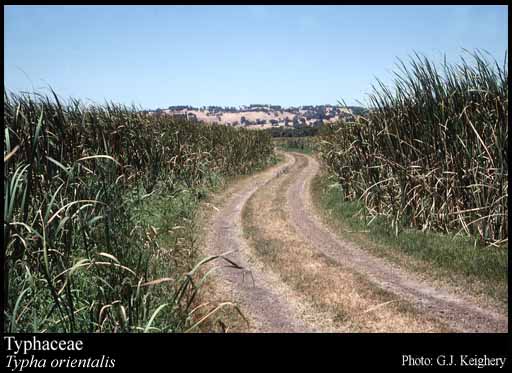- Reference
- Gen.Pl. [Jussieu] 25 (1789)
- Name Status
- Current







Scientific Description
Common name. Cat-tail family.
Habit and leaf form. Aquatic herbs. Perennial; plants with a basal concentration of leaves, or with neither basal nor terminal concentrations of leaves; rhizomatous. Hydrophytic to helophytic; rooted. Leaves emergent; alternate; distichous; leathery; sessile; sheathing; simple. Leaf blades entire; triangular in section or flat; linear; parallel-veined; without cross-venules. Leaves with a persistent basal meristem, and basipetal development. Vegetative anatomy. Plants with silica bodies, or without silica bodies. Leaf anatomy. Guard-cells not ‘grass type’. Stem anatomy. Secondary thickening absent.
Reproductive type, pollination. Fertile flowers functionally male and functionally female. Unisexual flowers present. Plants monoecious. Female flowers with staminodes. Male flowers without pistillodes. Anemophilous.
Inflorescence and flower features. Flowers densely aggregated in ‘inflorescences’; compound, dense in spikes. Inflorescences scapiflorous; terminal; a dense compound spike, with condensed secondary/tertiary branches formed from closely approximated annular meristems, the female flowers in the lower part, the males above. Flowers small. Floral receptacle developing a gynophore (sometimes, in the female flowers, to which the perianth-hairs may be adnate), or with neither androphore nor gynophore. Perigone tube absent. Hypogynous disk absent. Perianth vestigial (in the form of simple, lobed or forked hairs); 1–10(–20) (? — commonly 3 in the males, 1–4 in the females); 1–5 -whorled (irregular); free, or joined (somewhat adnate to the slender, elongated axis). Fertile stamens present, or absent (female flowers). Androecium (1–)3(–5). Androecial members free of the perianth; coherent (by the filaments); 1 - adelphous (the filaments joined basally for variable distances). Androecium exclusively of fertile stamens. Stamens (1–)3(–5). Anthers basifixed; non-versatile; dehiscing via longitudinal slits; extrorse (when recordable); tetrasporangiate; appendaged (via apical projection of the connective). Pollen shed as single grains (usually), or shed in aggregates; rarely in tetrads. Fertile gynoecium present, or absent (male flowers). Gynoecium 1 carpelled. The pistil 1 celled. Gynoecium monomerous; of one carpel; superior. Carpel stylate; apically stigmatic; 1 ovuled. Placentation apical. Stigmas dry type; non-papillate; Group II type. Ovules pendulous; non-arillate; anatropous.
Fruit and seed features. Fruit non-fleshy. The fruiting carpel dehiscent; a follicle (but tiny and achene-like before dehiscence). Dispersal unit the fruit (with the perianth-hairs forming a parachute). Dispersal by wind. Fruit 1 seeded. Seeds endospermic. Endosperm oily. Seeds with starch. Cotyledons 1. Embryo achlorophyllous (1/2); straight. Seedling. Hypocotyl internode absent. Mesocotyl absent. Seedling collar not conspicuous. Cotyledon hyperphyll elongated; assimilatory; more or less circular in t.s. Coleoptile absent. First leaf dorsiventral. Primary root ephemeral.
Physiology, biochemistry. Photosynthetic pathway: C3.
Geography, cytology, number of species. World distribution: widespread, but absent from Madagascar, Malaysia, and the warm Americas. X = 15. 10 species.
Economic uses, etc. The leaves used in weaving chair bottoms and mats.